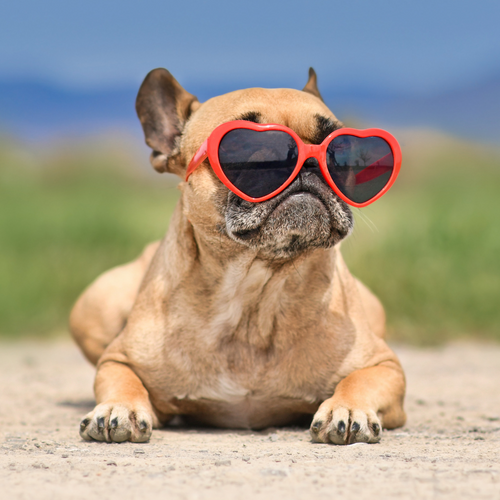Dogs, just like humans, can develop skin cancer through the sun’s harmful UV rays, yet most pet owners do not consider the risk of sunburn during the summer months. It is important that you know how to keep your dog safe while they’re having fun in the sun, especially if you're at the beach, and to keep them cool!
Which dogs are at risk?
Dogs that have dense fur coats will receive some natural protection from the sun’s rays, but the risk increases in dog breeds that have white hair and pink skin. Most dogs have areas of the body where they have thin fur or hair loss and it is in these places where the risk of sunburn increases.
The ears, nose and tummy are all vulnerable areas due to their lack of fur and by the time you notice these areas looking red, there will have already been sun damage.
Signs of sunburn in dogs
Look for areas of red or sore skin, dry cracked ear tips and hair loss in affected areas. Your dog’s skin is also likely to be tender and sore where it is sun damaged. If you notice that your pet has sunburnt areas, you can soothe their skin with aloe vera, witch hazel or coconut oil, which won’t sting and are safe for dogs.
How serious is sunburn in dogs?
Sunburn on a dog can be very uncomfortable and even painful but it is the fact it can lead to more serious health conditions. Just as in humans, dogs are also at risk of cancer. Sun damage can cause the progressive skin disease Solar dermatitis. This in turn can lead to a type of cancer called squamous cell carcinoma (SCC).
SCC usually starts on the tips of the ears or nose with crusty patches that look a bit like scabs. Once diagnosed, unfortunately surgery is the only way to control of the disease.
Preventing sunburn
For dogs that have light-coloured coats and skin, or only a thin covering of hair, it is a good idea for them to be kept out of the sun during the hottest part of the day in summer – between 10am and 4pm.
If your furry friend is very active and can't be persuaded to refrain from outdoor activities, then sunscreen is your best option. It's important to use a formula specially designed for dogs, has a blocking factor of at least 30 and includes protection from both UVA and UVB radiation. Unfortunately human sunscreens use ingredients such as zinc oxide which can cause poisoning if ingested by dogs.
If your dog is not keen on sunscreen, they have particularly thin fur or large areas of exposed skin, you could invest in some protective clothing to keep them safe during the summer months. Sun suits for dogs are specially designed to cover their whole bodies, so owners only need to put sunscreen on their faces. This can save time and means that you don’t need to worry about your dog licking off any sunscreen that you apply.
How to apply sunscreen to your dog
Before you use any sunscreen on your dog, it is advisable to test it on a small patch of their skin first in case of skin irritation. Apply a small amount to one area of your dog – preferably somewhere that is not going to be easy for them to lick – and keep an eye on it for 24 hours for any sign of irritation. If all is clear then you can start using it on your dog during sunny days.
Very gently apply a thin layer of sunscreen to your dog’s nose, and the front and back of their ears, being careful not to get any in their eyes. Spread sunscreen evenly over the rest of your dog’s skin and allow it to soak in for a few minutes, distracting your dog at this time with a toy or treat to prevent them from licking it off.
Make sure to be a responsible pet owner!
If you enjoyed this post, you may be interested in:




